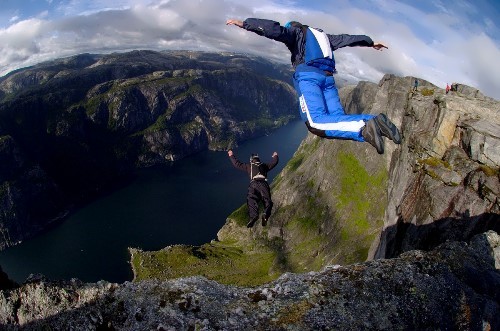BASE jumping – extreme sport
BASE (Building, Antenna, Span, and Earth) jumping is the sport of using a parachute to jump from fixed objects. It is much more dangerous than skydiving from aircraft and is currently regarded as a fringe extreme sport.
There are isolated examples of BASE jumps dating from the early 1900s. Frederick Law jumped from the Statue of Liberty in 1912; Michael Pelkey and Brian Schubert jumped the cliff “El Capitan” in Yosemite Valley in 1966; and in 1976, Rick Sylvester jumped Canada’s Mt Asgard for the opening sequence of the James Bond movie “The Spy Who Loved Me”, giving the wider world its first look at BASE jumping.
The acronym “BASE” was coined by film-maker Carl Boenish, who in 1978 filmed the first jumps from El Capitan to be made using ram-air parachutes and freefall tracking technique. BASE jumping became more widely among parachutists. Boenish continued to publish films and informational magazines on BASE jumping until his 1984 death on a cliff jump in Norway.
BASE jumping – extreme sport
BASE jumping grew out of skydiving. There are three main technical differences between the two. Firstly, BASE jumps are generally made from much lower altitudes than skydives. Secondly, a BASE jump takes place in close proximity to the cliff or tower which provided the jump platform. Thirdly, the BASE jumper generally has a lower airspeed than a skydiver throughout the jump, because a BASE jump starts with zero airspeed.
Skydiving parachutes are reefed to slow down the opening and reduce opening shock forces. The cliff or tower presents a risk to the BASE jumper if, for example, the parachute opens facing backwards. An experienced skydiver is recommended to deploy their parachute no lower than 2,000 feet (610 m).
BASE jumping – extreme sport
In parachuting, height is safety, and by making lower altitude jumps, BASE jumpers give up the safety margins built into skydiving. The lower airspeed of a BASE jump is also a risk factor. Skydivers use the air flow to stabilise their position, allowing the parachute to deploy cleanly. BASE jumpers, falling at lower speeds, have less aerodynamic control, and may tumble. The attitude of the body at the moment of jumping determines the stability of flight in the first few seconds, before sufficient airspeed has built up to enable aerodynamic stability. On low BASE jumps, parachute deployment takes place during this early phase of flight, so if a poor “exit” leads into a tumble, the jumper may not be able to correct this before the opening.
The legal issues that a BASE jumper must consider concern permissions to use the object that is being jumped, and the area used for landing.
BASE jumping is often featured in action movies, like the Vin Diesel film xXx where Diesel’s character catapults himself off a bridge in an open-topped car, landing safely as the car crashes on the ground. After the 1976 Mt Asgardjump, the James Bond movies continued to feature BASE jumps, including one from the Eiffel Tower in 1985’s A View to a Kill, the Rock of Gibraltar in 1987’s The Living Daylights, and in Die Another Day, 2002, Pierce Brosnan as James Bond jumps from a melting iceberg. Of the James Bond jumps, though, only the Mt Asgard and Eiffel Tower jumps were filmed in reality; the rest were special effects.
(From Let Speak English magazine)









